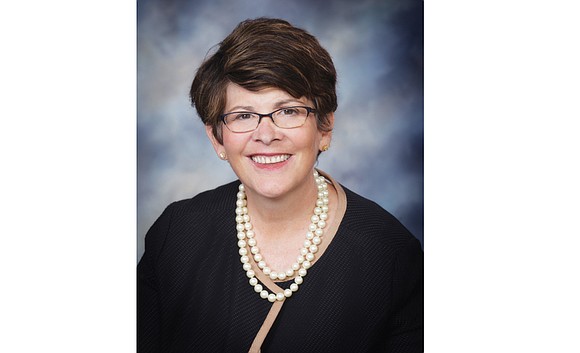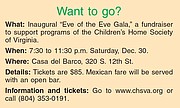Personality: Kathryn Wall
Spotlight on board chair of Children’s Home Society of Va.
12/1/2017, 7:17 p.m.
Kathryn Wall has always loved children. After meeting Nadine Marsh-Carter, CEO of the Children’s Home Society of Virginia, and being overwhelmed by some of the stories about youngsters that were shared, Ms. Wall was inspired to get involved. She is chair of the nonprofit Richmond/organization’s board of directors, a volunteer position she loves.
“Those stories resonated with me and my love of children, and I wanted to advocate for adopted children,” Ms. Wall says. “Their mission compelled me to be involved.”
CHS was founded in 1900 to find permanent families for homeless orphans. Today, the agency is working with new generations of children with no place to call home. To date, CHS has placed more than 13,500 children in adoptive homes. The agency helps families through the process and continues to support children and families after the adoptions are final.
Permanence is part of the CHS mission, Ms. Wall explains. When a child is unconditionally anchored and supported by an adoptive family providing a lifelong, safe, stable and genuine relationship honoring the child’s traditions, heritage and connections, a child becomes more stable, with high self-esteem, she says.
“If you think about permanence, think about your own relationship with your family. How important it is to have that connection?” she asks.
“If adoptive kids don’t have that connection, then they are more likely to be incarcerated, become homeless and/or have a greater incidence of teen pregnancy.”
Since the agency was established, the adoption landscape has shifted, Ms. Wall says. Many of the children are not infants, the typical view that comes to mind with adoption. Many are pre-teens with behavioral problems, or they have been in multiple foster homes, or have been victims of abuse, she says.
“Prospective adoptive families require more understanding of the issues and require ongoing parenting support,” she says.
Children’s Home Society provides training, she notes. “Part of that is to try to understand these kids’ real problems and understand that they are going to be testing their adoptive parents because they have lived in fear for so long.”
So how do adoptive parents face such challenges when a child does not return their affection or the child has behavioral or trust issues?
“CHS provides training and resources, family support, respite care through post adoptive services for adoptive parents so they know they have a lifeline to help them and not give up on the child,” Ms. Wall says. Ongoing family workshops with social workers also provide parents with support and suggestions on how to deal with specific situations.
Children’s Home Society also has joined with the Better Housing Coalition for The Possibilities Project to help young adults ages 18 through mid-20s who have aged out of the foster care system. The program provides housing, life skills and counseling to help young adults learn to live successfully on their own.
“We help them obtain employment, pair them with a roommate who teaches them how to manage a budget, prepare meals, how to get to school,” Ms. Wall says.
While the private agency receives some government funding, it depends on private donations from individuals, corporations and foundations to carry out its work, Ms. Wall says.
Its inaugural “Eve of the Eve Gala,” a fundraiser 7:30 p.m. Dec. 30, at Casa del Barco, 320 S. 12th St., is designed also to attract younger volunteers — and possibly new adoptive families—by exposing them to CHS’ mission and activities.
“What foster children want in life is a permanent family,” Ms. Wall says. “They ask, ‘How do I find my permanent family?’ They want to be wanted.”
Meet adoption advocate and this week’s Personality, Kathryn Wall:
Occupation: Executive vice president of human resources for Mary Washington Healthcare in Fredericksburg.
Date and place of birth: May 20 in Washington.
Current residence: Fredericksburg.
Alma maters: Bachelor’s in art history, University of Virginia; master’s in education, George Washington University; and completed a fellows program in change managemadent, Johns Hopkins University.
No. 1 volunteer position: Chair of the board of directors, Children’s Home Society of Virginia.
CHS’ mission: To build strong, permanent families and lifelong relationships for Virginia’s at-risk children and youths.
How CHS accomplishes its mission: Children’s Home Society provides a continuum of programs and services built around permanency. These services include birth parent counseling; infant adoption; adoption out of the foster care system, particularly for teenagers; post adoption services, including respite care and, through a unique partnership with the Better Housing Coalition, The Possibilities Project, which is designed to provide housing and full wrap-around services for youths who have aged out of the foster care system. CHS is also proud to be one of only three Virginia recruiters for Wendy’s Wonderful Kids, a signature program of the Dave Thomas Foundation for Adoption, a national nonprofit finding forever families for children in foster care.
Agency’s No. 1 challenge: Our main challenge is getting teenagers adopted into permanent homes. There is limited funding available from the state Department of Social Services, so it is crucial to make and exceed our private fundraising goals so that we can continue to support these vulnerable children and youth.
CHS’ annual budget: About $1.8 million.
How and why I find time for this volunteer responsibility: I believe in the mission of CHS. With more than 700 children waiting for permanent families here in Virginia, it is essential that we help. It is the right thing to do for our communities. Without support, many of the kids who age out of foster care face incredible odds and I want to ensure that all of Virginia’s kids have a bright future. I also am in awe of the CHS team. They are unsung heroes who give unselfishly to help create families.
Goals for your tenure as board chair: To support the agency in the completion of the strategic plan that focuses on four areas — growing programs and service, ensuring that we are able to attract and retain top talent, meeting our financial goals and being seen as an expert for addressing the needs of at-risk children.
Strategy for achieving it: By using evidence-based, trauma-informed methods, we provide the stability many of these young people have never had and the hope to fulfill their dreams through safe housing, intensive case management, counseling, mentoring and life skills training. We help our young people thrive by developing a plan for the future and then helping them live it.
Number of children served by CHS: Since 1900, more than 13,500 children have been adopted through CHS. In FY 2016, we served more than 785 children and families.
Age of children: Infants to age 25.
Reasons children are in foster care: Kids enter foster care for a variety of reasons. They are in an unsafe home where abuse or neglect occurs, their parents are not able to parent, increasingly as a result of opioid abuse, or they have lost their parents.
Why adopt: Kids in foster care are there through no fault of their own. What they need is a permanent, loving family that will help them develop into trusting, successful adults. By adopting, you can truly change lives, including your own.
Advice for families considering adoption: Get lots of support and learn all you can. At CHS, we provide significant training to prospective adoptive families and continuous support throughout the adoption process. This includes working with families once an adoptive placement is made and after the adoption is finalized to ensure the new family will thrive.
Myths about adopting teens in foster care: That it costs a lot of money to adopt. While there are placement fees usually associated with infant adoption, there are no placement fees to adopt a teen. In addition, the adoption tax credit can offset what minimal costs there are for home studies or training. We don’t want fees to be a barrier to adoption because these young people are no less deserving than our own kids to be part of a loving, permanent family.
Difference between a foster parent and foster-to-adopt parent: A foster parent goes into the fostering relationship with the understanding that the placement will be temporary until the child can return home. With foster-to-adopt, the family goes into the placement knowing that the child’s placement may become permanent.
Relationship children have with biological family once placed with adoptive families: It varies depending on the circumstances of the adoption. Our priority is always what is in the child’s best interest. In some cases, the child will continue to have a relationship with the biological family. In others, particularly where there has been significant abuse or neglect, such a relationship might not be in the best interest of the child.
How I start the day: One of my favorite sayings is “Greet the new year with joy.” I try to practice this every day — “Greet the new day with joy.” I have lots to be thankful for and try to not take anything for granted.
A perfect day for me is: Spending time with my family and friends and my golden retriever, Milly, maybe at the beach.
If I had more time, I would: Spend more time improving my photography skills.
Something I love to do that most people would never imagine: I am an open book so most of my friends know that I love to travel and that dogs are one of my joys.
A quote that I am inspired by: “I thought that I was given all things to enjoy life, but I was given life to enjoy all things.”
How I unwind: My dog is the best way to unwind.
The person who influenced me the most: I have wonderful parents who worked hard and share with me the value of hard work, dedication and generosity. My dad has the best life lessons, including my favorite, “Get the peanut butter out of your ears.” Translation — make sure you are listening!
Book that influenced me the most: “Christy” by Catherine Marshall.
What I’m reading now: I just finished “The Other Alcott” by Elise Hooper. It is a fictionalized story of Louisa May Alcott’s sister, May, who was an artist.
My next goal: I am doing a photography workshop this summer and I really want to improve my skills and then go to the Galapagos Islands.









